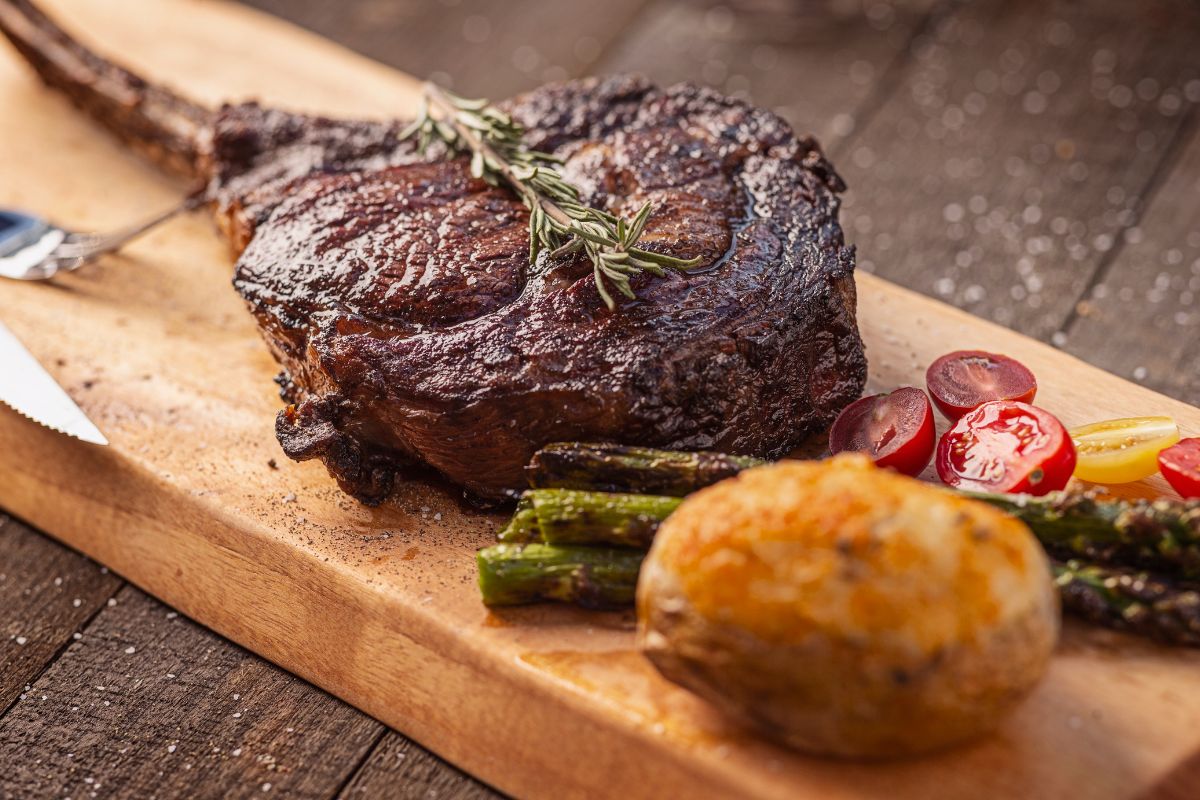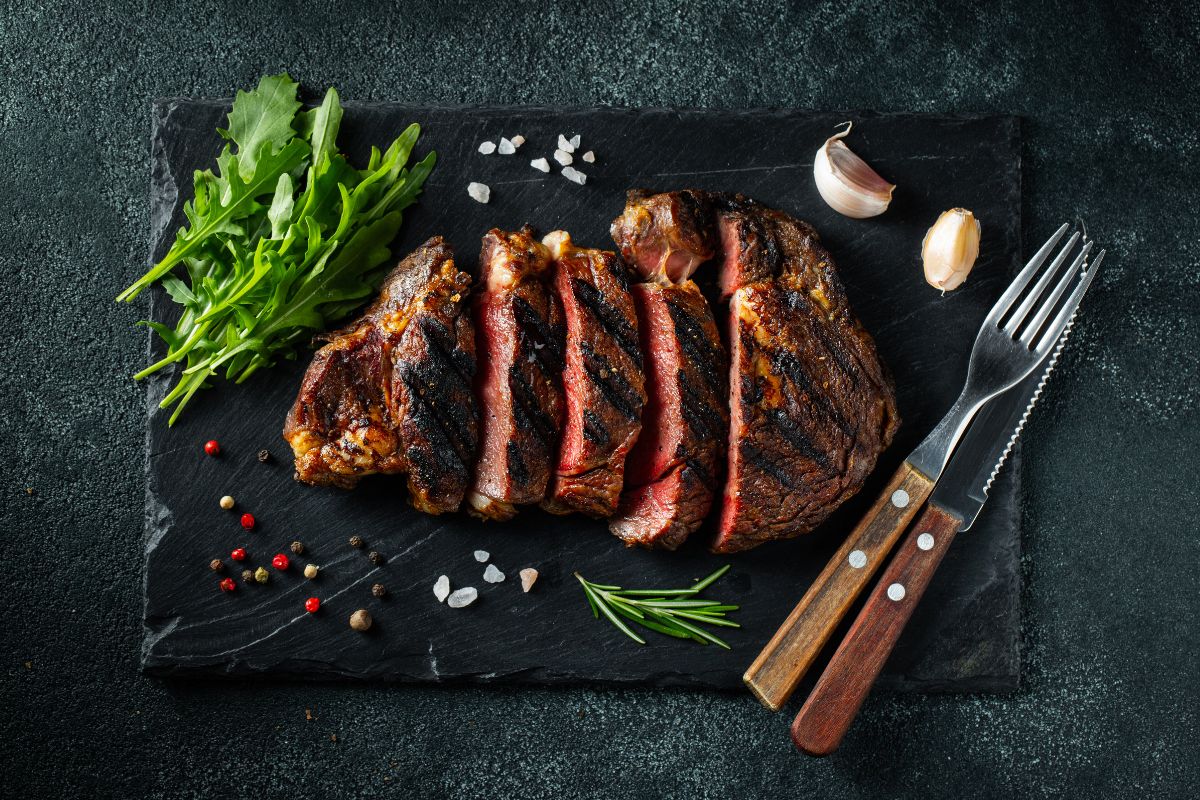If you have ever been to Texas Roadhouse before, then you may wonder what the difference between Fort Worth Ribeye and Bone-In Ribeye is. Well, you’ve come to the right place!
You can’t go wrong with a good steak. Although, you may be wondering: what cut of steak should I choose?

Well, there are a few cuts of steak you can choose from. This includes sirloin, filet, porterhouse T-bone, and New York strip.
Every cut of steak has its own pros and cons. For instance, when it comes to tender cuts of filets, these can dry out more easily, whereas bone cuts can be tougher and more complex in flavor.
Some of the most popular cuts include bone-in ribeye and Fort Worth ribeye. With this in mind, this article will explore the differences between Fort Worth ribeye and bone-in ribeye to help you make the decision.
Let’s get started.
What Is Ribeye Steak?
Ribeye steaks are among some of the most popular and common cuts of steak. They are juicy, tender, and bursting with delicious flavors.
In fact, they contain the perfect balance of fat to produce delicious results.
You can prepare a ribeye steak to be boneless or bone-in – this means that a small bone can be found in the finished product.
When it comes to this famous steak, there has been a never-ending debate about whether or not you should leave the bone in or out.
Simply put, ribeye steaks tend to be the most flavorful and richest cuts of meat – whether you enjoy it with the bone-in or out.
This topic never reaches an agreement – which is perfectly fine. The answer to whether or not you include the bone is down to personal preference and taste.
Regardless of whether or not you include the bone, the marbled cut of meat has an enjoyable and distinctive flavor.
Each cut is juicy, smooth, and buttery – which can even be compared to prized cuts of steak including the NY Strip.
What Is The Difference Between Fort Worth Ribeye And Bone-In Ribeye?
Fort Worth is widely considered to be one of the best meat cuisines in town and is a highly sought-after cut of steak.
Since it has a high fat content, it is typically baked at high temperatures to create a crispy outer layer which ensures a juicy and succulent interior remains.
In addition to being a boneless cut, the Fort Worth steak is super simple to cook without having to worry about any of the meat being uncooked.
That said, since there is no bone, the steak misses some flavor.
However, thanks to its unique flavor profile, the steak offers a diverse comestible experience. Although, due to the addition of a bone, the meat requires low-medium heat and has to be cooked for longer to ensure the meat is completely cooked.
Additionally, the bone in a ribeye steak tends to contain less meat when compared to a Fort Worth ribeye due to the added bone weight.
Here, the bone helps to add depth to the taste and provides the meat with a robust and nutty flavor.
The Texture
When it comes to the texture of ribeye steak, we usually refer to how the meat feels. For instance, two ribeye steaks can be compared to holding two steaks in one hand.
After cooking, the texture of both steaks varies considerably. As a general rule of thumb, bone-in ribeye tends to have a chewier texture to fourth-round ribeye.
This is simply due to the thickness of the muscle found in each steak.
When compared to bone-in steak, the muscle of the steak tends to be thinner. This enables it to cook more evenly and provides the bone-in steak with an enhanced flavor.
Therefore, the steak is chewable and less rough. The bone provides the steak with robust muscles.
Alternatively, the Fort Worth ribeye cooks more unevenly and slowly. Therefore, making it chewy and hard when compared to boneless steak.
Taste

When it comes to flavor, both ribeyes share the same tastes. That said, some people claim that the bone helps to alter the taste.
However, regardless of whether or not the meat contains a bone, it shouldn’t affect the taste of the steak.
That said, it could contain sweet-tasting marrow. When cooked and the marrow spills over the meat it shouldn’t affect the overall taste of the meat.
Some people will vouch that the inclusion of bone marrows completely alters the overall taste of bone-in ribeye.
Since the bone can be found, it makes the flavor much more intense. Here, lipids, marrow, and minerals from the bones seep into the meats – making them more flavorful and juicy.
Overall, it features a more robust meaty flavor. Conversely, the Fort Worth ribeye steak melts on your tongue.
Shape
You shouldn’t notice any difference in shape when it comes to these two steaks.
At the center of the animal, along the rib cage is where the steak is sliced and rewarded with the most tender cut of meat.
What To Serve With Ribeye Steak?
If you have a Fort Worth ribeye or bone-in ribeye on your plate, then it is undeniably the star of the show. However, you’ll want something that complements the beefy goodness perfectly.
Since the steak itself is incredibly rich, you can keep the sides simple with roasted asparagus or a green salad.
If you have some room on the grill, you can even enjoy the asparagus cooked this way, too.
Although, if you’re looking for something slightly more heartier. Then you can opt for a baked potato with sour cream or butter. Compound butter can be added to the steak as well.
Does The Bone Make A Difference In Ribeye Steak?
Yes, the bone does make a difference. When it comes to grilling your steak, one of the main benefits of cooking the bone is insulation.
As opposed to the meat itself, the bones require more time to heat up and cool down. Therefore, the meat near the bone can be 5° to 10° cooler when it comes off the grill.
Final Thoughts
Despite being the same type of meat, there are a lot of differences between the Fort Worth ribeye and the bone-in ribeye.
The most noticeable difference is the fact that one contains a bone and one doesn’t. Whether you prefer your meat with or without the bone you’ll be rewarded with delicious results.







